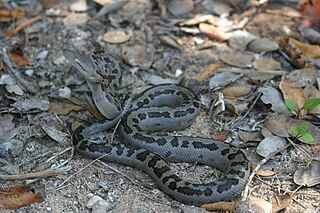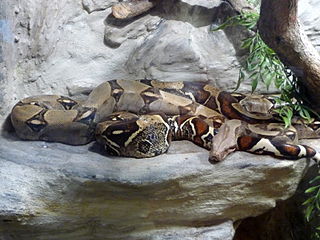
The Boidae, commonly known as boas or boids, are a family of nonvenomous snakes primarily found in the Americas, as well as Africa, Europe, Asia, and some Pacific islands. Boas include some of the world's largest snakes, with the green anaconda of South America being the heaviest and second-longest snake known; in general, adults are medium to large in size, with females usually larger than the males. Six subfamilies comprising 15 genera and 54 species are currently recognized.

Boa is a genus of boas found in Mexico, the Caribbean, and Central and South America. Five extant species, and one extinct, are currently recognized.

The rainbow boa is a boa species endemic to Central and South America. A semi-arboreal species, it is known for its attractive iridescent/holographic sheen caused by structural coloration. Five subspecies are currently recognized, including the nominate subspecies described here.

The green anaconda, also known as the giant anaconda, emerald anaconda, common anaconda, or common water boa, is a boa species found in South America and the Caribbean island of Trinidad. It is the largest, heaviest and the second longest snake in the world. No subspecies are currently recognized. Like all boas, it is a non-venomous constrictor.

The Puerto Rican boa is a large species of boa endemic to Puerto Rico. It is a terrestrial snake with a dark brown coloration. It grows to 1.9 m (6.2 ft) in length. It feeds on small mammals such as rodents and bats, birds and sometimes anole lizards. Like most boas, it is viviparous and kills its prey using constriction.

The Calabar python is a species of non-venomous snake in the family Boidae. The species is endemic to West and Central Africa. It is the only species in its genus.

Thelytoky is a type of parthenogenesis and is the absence of mating and subsequent production of all female diploid offspring as for example in aphids. Thelytokous parthenogenesis is rare among animals and reported in about 1,500 species, about 1 in 1000 of described animal species, according to a 1984 study. It is more common in invertebrates, like arthropods, but it can occur in vertebrates, including salamanders, fish, and reptiles such as some whiptail lizards.

Candoia is a genus of non-venomous boas found mostly in New Guinea, Melanesia and the Maluku Islands in Indonesia. Common names include bevel-nosed boas and keel-scaled boas.

Sanzinia madagascariensis, also known as the Madagascar tree boa or Malagasy tree boa, is a boa species endemic to the island of Madagascar. It was once considered conspecific with the Nosy Komba ground boa. Like all other boas, it is non-venomous.

Acrantophis dumerili, commonly known as Dumeril's boa, is a species of non-venomous snake in the family Boidae. The species is endemic to Madagascar. No subspecies are currently recognized.

Acrantophis madagascariensis is a species of boid snake in the subfamily Sanziniinae that is endemic to the island of Madagascar. Its common names include the Madagascar ground boa and Malagasy ground boa.

The Cuban boa, also known as the Cuban tree boa and by locals as majá de Santa María, is a very large species of snake in the family Boidae. With lengths exceeding 5 m (16 ft) and a relatively heavy build, the Cuban boa is one of the largest snakes in the world. The species is native to Cuba and some nearby islands. No subspecies are currently recognized.

Boa imperator is a large, heavy-bodied, nonvenomous species of snake in the genus Boa that is commonly kept in captivity. Boa imperator is part of the family Boidae and is found in Mexico, Central America and South America west of the Andes Mountains. It is commonly called the Central American boa, northern boa, Colombian boa, common boa and common northern boa.

Titanoboa is an extinct genus of giant boid snake that lived during the middle and late Paleocene. Titanoboa was first discovered in the early 2000s by the Smithsonian Tropical Research Institute who, along with students from the University of Florida, recovered 186 fossils of Titanoboa from La Guajira in northeastern Colombia. It was named and described in 2009 as Titanoboa cerrejonensis, the largest snake ever found. It was originally known only from thoracic vertebrae and ribs, but later expeditions collected parts of the skull and teeth. Titanoboa is in the subfamily Boinae, being most closely related to other extant boines from Madagascar and the Pacific.

Chilabothrus chrysogaster, commonly known as the Turks and Caicos Islands boa or the Southern Bahamas boa, is a species of snake found in the Southern Bahamas and the Turks and Caicos Islands. Local names include the rainbow boa, the Bahamas cat boa, the rainbow snake, and the fowl snake. Like all boids, it is not a venomous species.

The Bahamian pygmy boa constrictor, also known as the Inagua trope or Bahama wood snake, is a species of nonvenomous snake in the family Tropidophiidae. The species is endemic to Great Inagua Island in the Bahamas.

Chilabothrus fordii, also known commonly as Ford's boa and the Haitian ground boa, is a species of snake in the family Boidae. There are three recognized subspecies.

The boa constrictor, also known as the common boa, is a species of large, non-venomous, heavy-bodied snake that is frequently kept and bred in captivity. The boa constrictor is a member of the family Boidae. The species is native to tropical South America. A staple of private collections and public displays, its color pattern is highly variable yet distinctive. Four subspecies are recognized.

Boa constrictor occidentalis, also commonly known as the Argentine boa, is a subspecies of large, heavy-bodied, nonvenomous, constricting snake. Boa constrictor occidentalis is a member of the family Boidae, found in the subtropical temperate west of Argentina and Paraguay, although some members have been reported to exist in Bolivia as well.























